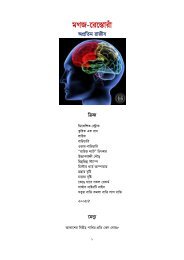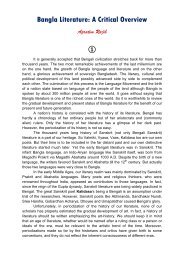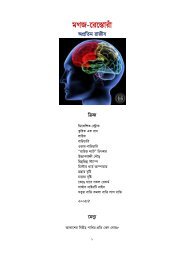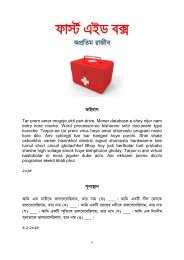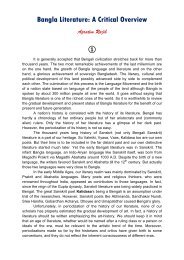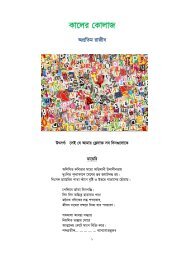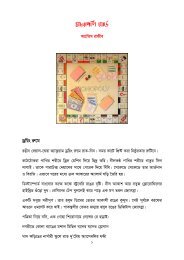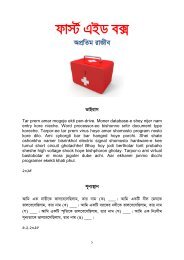Literature-Critique
Create successful ePaper yourself
Turn your PDF publications into a flip-book with our unique Google optimized e-Paper software.
47<br />
own queen. Thus he deprives the slave of his happiness forever. He orders the slave<br />
to laugh, the slave doesn’t and then inhuman torture is befallen on him. But the slave<br />
does not abide by the cruel ruler’s command till death.<br />
Beneath the surface of this story, Showkat tells us of life’s everlasting<br />
aspiration for survival and happiness. He prefers temporal life to an unearthly one,<br />
and he emphasizes man’s enjoyment of life. Only thinking of death and afterlife<br />
cannot be man’s aim. A life without freedom and pleasure is not a life at all; it is an<br />
eternal truth that was denied by our foreign rulers.<br />
His other remarkable novels are Boni Adam (The Mankind), Raja Upakhyan<br />
(The Tale of a King), Nekre Aranya (Wolves’ Forest) and Patanga Pinjar (Insects’<br />
Cage).<br />
Showkat’s novels emphasize humanity and human consciousness of life and<br />
the world. His Daria Bibi is a great woman despite her endless poverty and<br />
humiliation. His Tatar slave is an adamant rebel against all tyranny and persecution.<br />
Showkat’s artistic exposition and glorification of human character takes him to the<br />
hall of great humanists. He is a great artist whose works tell of sublime human<br />
nature to all-time readers.<br />
Syed Waliullah (1922-’71)<br />
A sense of morbidity and serene sadness is traced in the art and literature of<br />
East Bengal covering the time-span from the 1940s to 80s. It is found in poems,<br />
songs, paintings, novels and what not? This melancholic tone is set on country life<br />
with natural landscape. It is tinged with a sense of helplessness derived from the cry<br />
of pitiless poverty and uncertainty. Zainul Abedin’s paintings and Waliullah’s novels<br />
are the best representatives of this artistic archetype.<br />
Waliullah is specially known as an existentialist writer. However, this<br />
philosophy has few expositions in his first novel Lalshalu (Red Cloth). It rather<br />
conveys his reaction to fanaticism and fundamentalism. Majid, a shrewd person from<br />
a conservative Muslim family, comes to a village and announces an earth-pile<br />
covered by red cloth to be the shrine of a sacred pir (i.e. saint). He achieves some<br />
people’s obedience, and some others confront him (including his second wife<br />
Jamila), and he seems to overcome all difficulties through his shrewd tactics. It is the<br />
story of a religion-monger’s power-hunger, cruelty, ambition for riches and<br />
unrestricted lust. The novel is also celebrated for its poetic language.<br />
His second novel Chander Amabashya (The Darkness of the Moon) is a good<br />
example of existentialist fiction. It tells us the story of a school-teacher who comes<br />
close to a murder and does have a dilemma whether he will inform the police or keep<br />
it a secret, because he cannot be sure whether it was a murder and if was so, then<br />
who committed it. At last he becomes confirm of the crime and finds it his own<br />
responsibility to expose it. And doing so, he himself is charged with murder. The<br />
world, which is dominated by exploiters and persecutors, always backs its powerful<br />
patrons. Even the school-teacher’s local guardians, who simulate as `pious’ persons,<br />
are engaged in this hypocritical act. As a result, it is a story of a person’s inner




